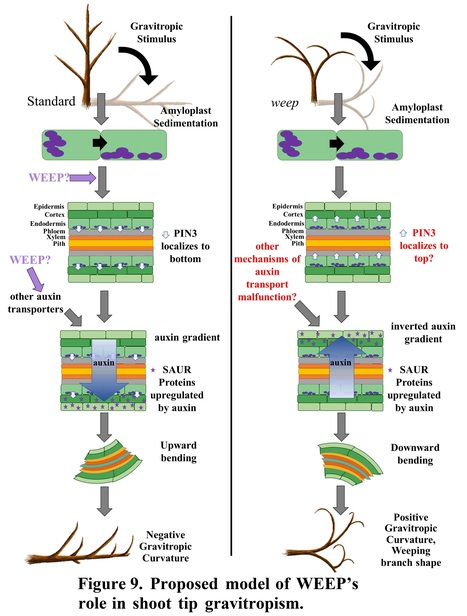
|
Scooped by Julio Retamales |
Authors: Andrea R. Kohler, Andrew Scheil, Joseph L. Hill, Jr., Jeffrey R. Allen, Jameel M. Al-Haddad, Charity Z. Goeckeritz, Lucia C. Strader, Frank W. Telewski and Courtney A. Hollender.
Plant Physiology (2024)
One-sentence summary: Polar auxin transport associated with gravitropism and lateral shoot and root orientation requires the highly conserved WEEP protein in peach.
Abstract: "Trees with weeping shoot architectures are valued for their beauty and are a resource for understanding how plants regulate posture control. The peach (Prunus persica) weeping phenotype, which has elliptical downward arching branches, is caused by a homozygous mutation in the WEEP gene. Little is known about the function of WEEP despite its high conservation throughout Plantae. Here, we present the results of anatomical, biochemical, biomechanical, physiological, and molecular experiments that provide insight into WEEP function. Our data suggest that weeping peach trees do not have defects in branch structure. Rather, transcriptomes from the adaxial (upper) and abaxial (lower) sides of standard and weeping branch shoot tips revealed flipped expression patterns for genes associated with early auxin response, tissue patterning, cell elongation, and tension wood development. This suggests that WEEP promotes polar auxin transport toward the lower side during shoot gravitropic response, leading to cell elongation and tension wood development. In addition, weeping peach trees exhibited steeper root systems and faster lateral root gravitropic response. This suggests that WEEP moderates root gravitropism and is essential to establishing the set-point angle of lateral roots from the gravity vector. Additionally, size-exclusion chromatography indicated that WEEP proteins self-oligomerize, like other proteins with sterile alpha motif (SAM) domains. Collectively, our results from weeping peach provide insight into polar auxin transport mechanisms associated with gravitropism and lateral shoot and root orientation."
Julio Retamales's insight:
This relevant article was already posted here when published as a preprint.
No comment yet.
Sign up to comment



 Your new post is loading...
Your new post is loading...







